Peak Everything (4 page)
Authors: Richard Heinberg

Our socio-historical context takes some time and perspective to appreciate. Upon first encountering Peak Oil, most people tend to assume it is merely a single isolated problem to which there is a simple solution â whether of an eco-friendly nature (more renewable energy) or otherwise (more coal). But prolonged reflection and study tend to eat away at the viability of such “solutions.” Meanwhile, as one contemplates how we humans have so quickly become so deeply dependent on the cheap, concentrated energy of oil and other fossil fuels, it is difficult to avoid the conclusion that we have caught ourselves on the horns of the Universal Ecological Dilem - ma, consisting of the interlinked elements of population pressure, resource depletion, and habitat destruction â on a scale unprecedented in history.
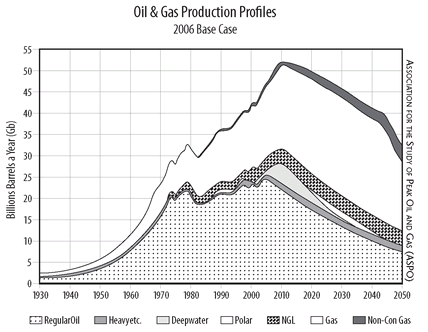
Figure 1
. Production profiles for world oil and natural gas, history and forecast.
. Production profiles for world oil and natural gas, history and forecast.
Petroleum is not the only important resource quickly depleting. Readers already acquainted with the Peak Oil literature know that regional production peaks for natural gas have already occurred, and that over the short term the economic consequences of gas shortages are likely to be even worse for Europeans and North Americans than those for oil. And while coal is often referred to as being an abundant fossil fuel, with reserves capable of supplying the world at current rates of usage for two hundred years into the future, recent studies updating global reserves and production forecasts conclude that global coal production will peak and begin to decline in ten to twenty years.
4
Because fossil fuels supply about 85 percent of the world's total energy, peaks in these fuels virtually ensure that the world's energy supply will begin to shrink within a few years regardless of any efforts that are made to develop other energy sources.
4
Because fossil fuels supply about 85 percent of the world's total energy, peaks in these fuels virtually ensure that the world's energy supply will begin to shrink within a few years regardless of any efforts that are made to develop other energy sources.
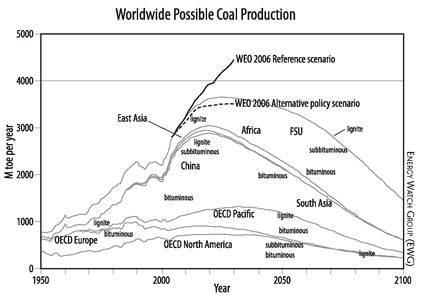
Figure 2
. Global coal production, history and forecast. The International Energy Agency's “World Energy Outlook 2006” (WEO 2006) discusses two future scenarios for global coal production: a “reference scenario” that assumes unconstrained coal consumption, and an “alternative policy scenario” in which consumption is capped through government efforts to reduce climate impacts. Both scenarios are compatible with the supply forecast here (EWG report, 2007) until about 2020. Thereafter, only a rate of demand corresponding with the “alternative policy scenario” can be met.
. Global coal production, history and forecast. The International Energy Agency's “World Energy Outlook 2006” (WEO 2006) discusses two future scenarios for global coal production: a “reference scenario” that assumes unconstrained coal consumption, and an “alternative policy scenario” in which consumption is capped through government efforts to reduce climate impacts. Both scenarios are compatible with the supply forecast here (EWG report, 2007) until about 2020. Thereafter, only a rate of demand corresponding with the “alternative policy scenario” can be met.
Nor does the matter end with natural gas and coal. Once one lifts one's eyes from the narrow path of daily survival activities and starts scanning the horizon, a frightening array of peaks comes into view. In the course of the present century we will see an end to growth and a commencement of decline in all of these parameters:
⢠Population
⢠Grain production (total and per capita)
⢠Uranium production
⢠Climate stability
⢠Fresh water availability per capita
⢠Arable land in agricultural production
⢠Wild fish harvests
⢠Yearly extraction of some metals and minerals (including copper, platinum, silver, gold, and zinc)

Figure 3. Global uranium supply from known resources, history and forecast, compared with supply requirements.
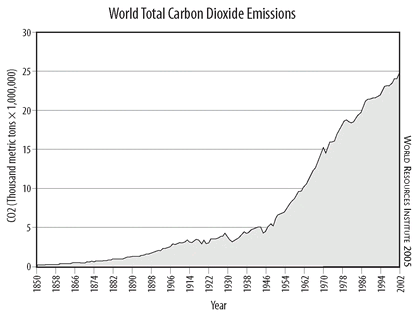
Figure 4. World total annual emissions.

Figure 5. Global mean surface temperature.
The point of this book is not to go systematically through these peak-and-decline scenarios one by one, offering evidence and pointing out the consequences â though that is a worthwhile exercise, and it is instructive to contemplate a few graphs showing the general trends (see
figures 1
through 5). Some of these peaks are more speculative than others. Fish harvests are already in decline, so this one is hardly arguable; however, projecting extraction peaks and declines for some metals requires extrapolating current rising rates of usage many decades into the future.
5
The problem of uranium supply beyond mid-century is well attested by studies, but has not received sufficient public attention.
6
figures 1
through 5). Some of these peaks are more speculative than others. Fish harvests are already in decline, so this one is hardly arguable; however, projecting extraction peaks and declines for some metals requires extrapolating current rising rates of usage many decades into the future.
5
The problem of uranium supply beyond mid-century is well attested by studies, but has not received sufficient public attention.
6
Nevertheless, the general picture is inescapable: it is one of mutually interacting instances of overconsumption and emerging scarcity.
Our starting point, then, is the realization that we are today living at the end of the period of greatest material abundance in human history â an abundance based on temporary sources of cheap energy that made all else possible. Now that the most important of those sources are entering their inevitable sunset phase, we are at the beginning of a period of overall societal contraction.
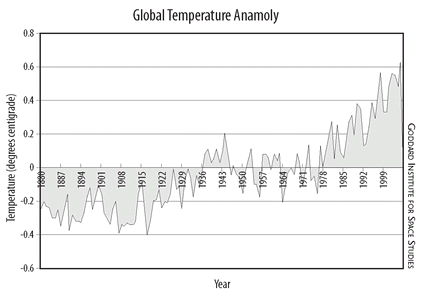
Figure 6. The global temperature anomaly is a measure of the difference between the mean global temperature at a given point in time and the average global temperature during the 20
th
century.
th
century.
This realization is strengthened as we come to understand that it is no happenstance that so many peaks are occurring together. They are all causally related by the historic reality that, for the past 200 years, cheap, abundant energy from fossil fuels has driven technological invention, increases in total and per-capita resource extraction and consumption (including food production), and population growth. We are enmeshed in a classic self-reinforcing feedback loop:
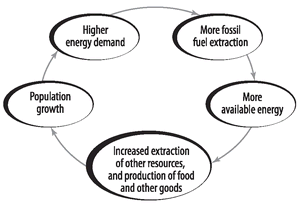

Self-reinforcing feedback loops sometimes occur in nature (population blooms are always evidence of some sort of reinforcing feedback loop), but they rarely continue for long. They usually lead to population crashes and die-offs. The simple fact is that growth in population and consumption cannot continue unabated on a finite planet.
If the increased availability of cheap energy has historically enabled unprecedented growth in the extraction rates of other resources, then the coincidence of Peak Oil with the peaking and decline of many other resources is entirely predictable.
Moreover, as the availability of energy resources peaks, this will also affect various parameters of social welfare:
⢠Per-capita consumption levels
⢠Economic growth
⢠Easy, cheap, quick mobility
⢠Technological change and invention
⢠Political stability
All of these are clearly related to the availability of energy and other critical resources. Once we accept that energy, fresh water, and food will become less freely available over the next few decades, it is hard to escape the conclusion that while the 20
th
century saw the greatest and most rapid expansion of the scale, scope, and complexity of human societies in history, the 21
st
will see contraction and simplification. The only real question is whether societies will contract and simplify intelligently or in an uncontrolled, chaotic fashion.
Good News? Bad News?th
century saw the greatest and most rapid expansion of the scale, scope, and complexity of human societies in history, the 21
st
will see contraction and simplification. The only real question is whether societies will contract and simplify intelligently or in an uncontrolled, chaotic fashion.
None of this is easy to contemplate. Nor can this information easily be discussed in polite company: the suggestion that we are at or near the peak of population and consumption levels for the entirety of human history, and that it's all downhill from here, is not likely to win votes, lead to a better job, or even make for pleasant dinner banter. Most people turn off and tune out when the conversation moves in this direction; advertisers and news organizations take note and act accordingly. The result: a general, societal pattern of denial.
Other books
The Best Man's Baby by Victoria James
Tyack & Frayne Mysteries 01 - Once Upon A Haunted Moor by Harper Fox
Prelude to a Fantasy: Prequel to Harmless Book 8 by Melissa Schroeder
Cafe Scheherazade by Arnold Zable
The Truth by Erin McCauley
Heir of Fire by Sarah J. Maas
Keepers of the Covenant by Lynn Austin
The Road In Is Not the Same Road Out by Karen Solie
The Third Silence by Nancy Springer
3 Days by Madden, Krista
